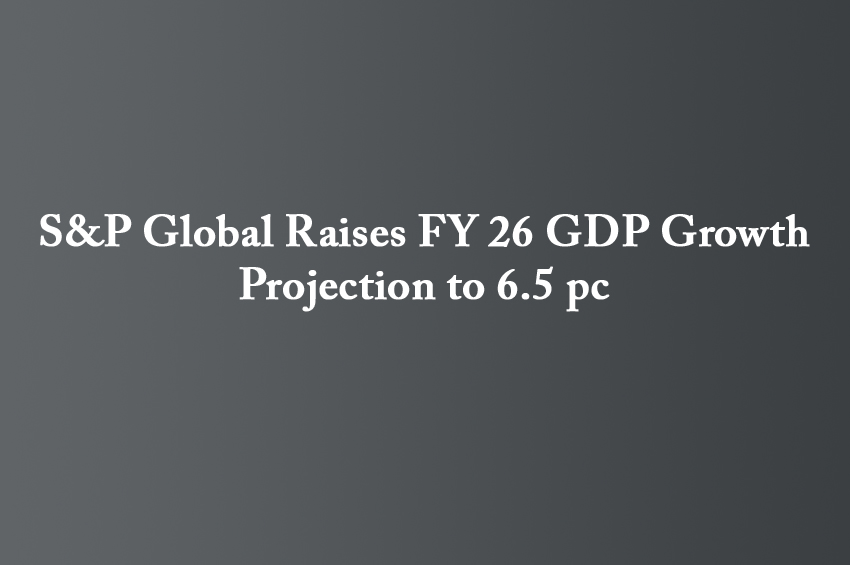Winning Bizness Economic Desk
S&P Global has upped its forecast for India’s economic growth for the current fiscal (FY 26) to 6.5 per cent from its earlier estimate of 6.3 per cent.
S&P Global cited monetary easing, lower crude oil prices and normal monsoon for raising the forecast.
In its latest Asia-Pacific Economic Outlook report, S&P Global said that the country’s domestic demand growth was likely to remain more resilient than exports.
“We see India’s GDP growth holding up at 6.5 per cent in fiscal 2026 (year-ending March 31, 2026). That forecast assumes a normal monsoon, lower crude oil prices, income-tax concessions and monetary easing,” the rating agency said.
S&P Global’s growth projection for the Indian economy is in line with the Reserve Bank of India (RBI)’s estimate.
The RBI Monetary Policy Committee earlier this month pegged India’s gross domestic product growth for 2025-26 at 6.5 per cent.
For the April-to-June quarter, the growth is pegged at 6.5 per cent; for Q2 and Q3 at 6.7 per cent and 6.6 per cent, respectively, and for Q4 at 6.3 per cent.
While the globally-renowned rating agency highlighted heightened risks to the global economy due to geo-political turbulence in West Asia, it ruled out any major spike in oil prices.
“Current conditions on global energy markets which are well-supplied make such long-term impact on oil prices unlikely,” it said.
Here, it must be pointed out that oil prices had spiked in the last two weeks due to the concerns over the closure of the Strait of Hormuz, a key shipping route for oil and gas, amid escalation in the Israel-Iran conflict.
Now, however, there is a cease-fire between the two countries.
Earlier, S&P Global had lowered India’s GDP growth projection by 20 basis points (bps) to 6.3 per cent citing uncertainties over the US tariff policies. Now it has gone back to its earlier projection of 6.5 per cent.
What requires highlighting here is that projections by other major agencies are lower.
For example, the World Bank had earlier in its Global Economic Prospects report lowered India’s economic growth projection to 6.3 per cent, citing weaker external demand and trade barriers.
In April, the International Monetary Fund (IMF) had lowered the country’s GDP growth projections for the current financial year by 30 basis points to 6.2 per cent.
For the financial year ended March 2025 (FY 25), the Indian economy had posted a growth of 6.5 per cent, which, it must be highlighted, was the slowest pace of expansion since the Covid pandemic hit the world in 2020-21, as per the latest data released by the National Statistics Office (NSO).
Despite the slowdown, India maintains its position as the fastest-growing major economies globally.
Reliance Defence Bags Rs 600-cr Export Order from German Company
Reliance Defence Limited has announced the securing of a Rs 600-crore export order from a German company.
Reliance Defence is promoted by Reliance Infrastructure Limited and the German company is the defence and ammunition manufacturer Rheinmetall Waffe Munition GmBH.
Last month, the Anil Ambani-spearheaded company inked an agreement with German arms manufacturer Rheinmetall AG to supply ammunition like artillery shells and explosives from a new facility to be established in the western Indian state of Maharashtra.
“Reliance Defence’s export order is one of the largest in the hi-tech ammunition to date. This underscores the strength of its recently announced strategic partnership with Rheinmetall,” the German firm said in a statement.
The order represents a key milestone in Reliance Defence’s strategy to strengthen its position as a reliable partner in the global defence and munitions supply-chain. There would be a strong focus on Europe.
The Anil Ambani group company aims to be among the top three defence exporters in the country.
Rheinmetall AG’s CEO Mr Armin Papperger speaking about the strategic partnership, said that “this strategic partnership of Rheinmetall with Reliance Defence led by Anil Ambani’s Reliance Group illustrates our strong commitment to partner with India under the strong leadership of Prime Minister Narendra Modi.”
Speaking on the same, the Founder-Chairman of the Reliance Group Mr Anil Ambani said that the strategic partnership with Rheinmetall brought cutting-edge capabilities to India and represented a defining milestone for the country’s private defence manufacturing sector.
Reliance Defence would establish an integrated facility for manufacturing explosives, ammunition and small arms under the ambitious Dhirubhai Ambani Defence City (DADC) initiative.
The DADC is being developed in the Watad industrial area of Ratnagiri in Maharashtra. It is planned to become the largest greenfield project in the defence sector ever undertaken by the country’s private sector.
Aditya Birla Lifestyle Aims to Double Revenues in 5-Years
Aditya Birla Lifestyle Brands (ABLBL), a newly-listed company, has said that it plans to invest Rs 300-crore every year with an aim to double its revenue in the next five-years.
The Aditya Birla Group company which was de-merged from Aditya Birla Fashion and Retail, will invest around Rs 300-crore per year, its Managing Director Mr Ashish Dikshit was quoted in a leading publication as having said at a press conference recently.
Group Chairman Mr Kumar Mangalam Birla said that “India stands at the cusp of a transformative growth phase, with consumption poised to be a primary driver.”
ABLBL had a revenue of Rs 7,830-crore in FY 25, an operating profit margin of 15 per cent and a net profit of Rs 60-crore.
Mr Kumar Mangalam Birla said that the company aspires to build the country’s first portfolio of billion-dollar brands in the fashion and lifestyle segments.
The firm presently sells brands such as Peter England, Allan Solly, van Heusen and Louis Philippe.
Two of the company’s brands have clocked sales of over Rs 2,000-crore per year while two others are above the Rs 1,000-crore mark per year, Mr Dikshit informed.
“Over the next five-years, we aim to more than double our scale and more than triple our cash profits. This growth will be strategic, disciplined and powered by strong cash flows,” he said.
The company also targets to double its revenues as well, he added.
According to Mr Dikshit, the last two-years had been difficult for the industry but he said that it was cyclic and the company had seen many such turns in the last 25-years of its existence.
On the investments front, the senior company official said that the company has a capex plan of Rs 300-crore per year.
“A large part of it is going through the expansion of the retail network, a small part towards the internal capabilities and technology,” Mr Dikshit said.
The company is aiming for a three-fold jump in the profitability over the next three-to-five-year period, he informed.
Sowing Data Encouraging, Monsoon Could Bring Lot of Cheer to India
India’s agriculture ministry has released data that reveals that the rural economy may be poised for yet another strong year following trends showing a pick-up in sown area.
This is despite a two-week dry spell in June, the first month of the monsoon.
According to the data released until June 20, the total area sown stood at 13.78-million hectares, 10.4 per cent higher than the 12.49-million hectares sown during the same period last year.
Rice and pulses have contributed significantly to this increase.
Rice sowing reached 0.13-million hectares—58.1 per cent higher than last year while pulses sowing moved northward by 42.2 per cent, with moong accounting for most of the gain.
Coarse cereals or millets, also registered a strong growth with area sown up 22 per cent as compared to the previous year.
On the other hand, oilseeds sowing remained flat, clocking a marginal two per cent slide.
Earlier, in June, the central government halved the import duty on crude edible oils to ease the burden of high inflation. A point to note here is that a 20 per cent duty had been imposed on edible oils in September 2024.
Cotton also appears to be on solid ground, with a seven per cent increase in area sown over last year.
However, experts have cautioned that the performance of the monsoon in the two months of July and August are the crucial ones as these two months typically account for the bulk of kharif sowing.
Here, it must be highlighted that food production has a higher correlation with rainfall performance in the two months of July and August.
While the monsoon had made early landfall this year, rainfall had weakened during the first-half of June; however, it has improved since then.
As of June 24, only eleven states were experiencing deficient rainfall while overall precipitation was four per cent above the 50-year average.
Reflecting this improvement were reservoir levels and as of June 19, storage across the country was 38.9 per cent above the normal level.
The southern region in particular saw water levels at 95 per cent above the average capacity.
However, the point to note is that in contrast, reservoirs in the northern and eastern regions remained below normal, with deficits of 10.8 per cent and 6.6 per cent, respectively.


